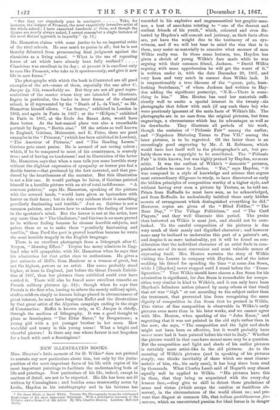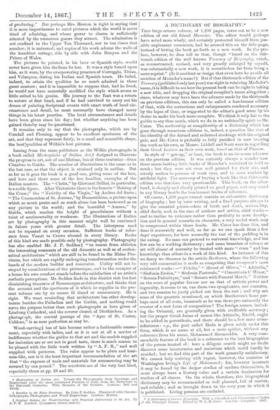NEW ILLUSTRATED BOOKS.
Mae. HEATON'S little memoir of Sir D. Wilkie* does not pretend to contain any new particulars about him, but only by the juxta- position of the most important facts of his life with copies of his most important paintings to facilitate the understanding both of life and paintings. New particulars of his life, indeed, except in matters of detail, are not to be expected. His life has been not ill written by Cunningham ; and besides some trustworthy notes by Leslie, Haydon in his autobiography and in his lectures has The Great Works of David Wilkie. Twenty-Six Photographs from the celebrated Engravings of his most important Paintings. With a descriptive Account of the Pictures and a Memoir of the Artist. By Biro. Charles Heaton. London: Bell and Daldy.
recorded in his explosive and ungrammatical but graphic man- ner, a host of anecdotes relating to "one of the dearest and earliest friends of his youth," which, coloured and even dis- torted by Haydon's self-conceit and jealousy, as their facts often are, yet have the weight due to the testimony of an eye- witness, and if we will but bear in mind the vice that is in them, may assist us materially to conceive what manner of man Wilkie really was. In those same lectures, too, Haydon has given a sketch of young Wilkie's face made while he was arguing with their common friend, Jackson. "David Wilkie arguing with some apprehension he will get the worst of it," is written under it, with the date December 20, 1807, and very keen and very much in earnest does Wilkie look. It is unquestionably a true likeness of the "queer, pale, keen- looking Scotchman," of whom Jackson had written to Hay- don adding the significant postscript, "N.B.—There is some-
thing in him." Mrs. Heaton has used her materials suffi- ciently well to excite a special interest in the twenty - six photographs that follow with such (if any such there be) who were previously ignorant of the main facts of Wilkie's life. The photographs are in no case from the original pictures, but from engravings, a circumstance which has its advantages as well as its drawbacks. They illustrate all periods of his work, though the omission of " Pitlessie Fair" among the earlier, and "Napoleon Dictating Terms to Pius VII." among the later pictures, is to be regretted. Of the latter there is an exceedingly good engraving by Mr. J. H. Robinson, which would have lent itself well to the photographer's art, but pro- bably there was a copyright to be conciliated. The " Pitlessie Fair" is little known, but was highly praised by Haydon, no mean critic. It was the earliest of Wilkie's " domestic" pictures, painted before he came to London. "Yet," says Haydon, "it was composed in a style of knowledge and science that argues most extraordinary diligence in study, to have discovered so early the hidden principles of composition worthy of a higher style, and without having ever seen a picture by Teniers, as he told me. Prints from Raffaelle he must have seen, as he acknowledged, and from Raffaelle he undoubtedly imbibed those early hidden secrets of arrangement which distinguished everything he did." However, copies are given of the " Blind Fiddler," "The Rent Day," "The Village Politicians," and "The Card Players," and they well illustrate this period. The praise thus bestowed on Wilkie is most just, and should not be over- looked. To the careful composition of his pictures is due very much of their manly and dignified character ; and however some may be inclined to undervalue this part of a painter's art, and despise it as mere technicality, yet it will be found on con- sideration that the individual character of an artist finds in com- position one of its most convenient and most valuable means of expressing itself. Mrs. Heaton narrates the story of Wilkie visiting the Louvre in company with Haydon, and of the latter scolding his friend for spending the time "at some Jan Steen, while I [Haydon] never stopped until I stood before the Trans- figuration." That Wilkie should have chosen a Jan Steen for his admiration is significant, for Jan Steen is remarkable for compo- sition very similar in kind to Wilkie's, and it can only have been Haydon's fallacious notion (shared by many others at that time) that art was " high " or not according to the subject rather than the treatment, that prevented him from recognizing the same dignity of composition iu Jan Steen that he praised in Wilkie. This virtue of fine composition is observable in Wilkie's early pictures even more than in his later works, and we cannot agree with Mrs. Heaton, when speaking of the "John Knox," and regretting that it was not painted in the old style rather than in the new, she says, "The composition and the light and shade might not have been so effective, but it would probably have meant more had it been painted before his visit to Italy." Whether the picture would in that case have meant more may be a question. But the composition and light and shade of his earlier pictures is certainly more artist-like in the old pictures. As to the meaning of Wilkie's pictures (and in speaking of his pictures simply, one thinks inevitably of those which are most charac- teristic of him, viz., his early ones), it has long since been read by thousands. What Charles Lamb said of Hogarth may almost equally well be applied to Wilkie. "His pictures have this in them, that they bring us acquainted with the every-day human face, —they give us skill to detect those gradations of sense and virtue (which escape the careless or fastidious ob- server), in the circumstances of the world about us ; and pre- vent that disgust at common life, that tedium quotidianarum for- marum, which an unrestricted passion for ideal forms is in danger of producing." But perhaps Mrs. Heaton is right in saying that I it is mere impertinence to extol pictures which the world is never I tired of admiring, and whose power to charm is sufficiently attested by the numerous gazers they attract. The admiration is not confined to the Upper Ten Thousand, nor to ten times that number; it is universal; and copies of his work adorns the walls of the humblest cottage, side by side with John Bunyan and the Prince of Wales.
The pictures he painted, in his later or Spanish style, would never have given him the fame he has. It was a style forced upon him, as it were, by the overpowering presence of Correggio, Titian, and Velasquez, during his Italian and Spanish tours. He failed, indeed, to attain the qualities he so much admired in those great masters ; and it is impossible to suppose that, had he lived, he would not have materially modified the style which seems so little suited to his genius. His journey to the East was a return to nature at first hand, and if he had survived to carry out his dream of painting Scriptural events with exact truth of local cir- cumstance and detail, he must necessarily have changed many things in his latest practice. The local circumstances and details have been given since his day ; but whether anything has been gained thereby may be questioned.
It remains only to say that the photographs, which are by Cundall and Fleming, appear to be excellent specimens of the art, and that they represent fairly, in a stnall and accessible shape, the best:qualities of Wilkie's best pictures.
Issuing from the same publishers as the Wilkie photographs is a book called Masterpieces of Italian Art,f designed to illustrate the progress in art, not of one lifetime, but of three centuries—from Cimabue to G-uido. The number of illustrations is the same as in the last case, so that the object is attained only in outline. But as far as it goes the book is a good one, giving some of the best, and here and there some of the less familiar, examples of the Italian masters. The "Christ," by Giovanni Bellini, in particular, is a noble figure. After Tintoretto there is the famous" Raising of the Cross ;" the "Nativity of the Virgin," by Andrea del Sado ; "The Communion of St. Jerome," by Domenichino, a picture upon which as much praise and as much abuse has been bestowed as on any picture in the world ; and the beautiful "Aurora," by Guido, which reaches the height of gracefulness without a taint of sentimentality or weakness. The illustrations of Italian art by photography in this manner might well be continued in future years with greater detail. The letterpress need not be repeated on every occasion. Sufficient books of refer- ence from Vasari to Crowe abound in every library. Books of this kind are made possible only by photography. Photography has also enabled Mr. J. P. Seddon t "to rescue from oblivion the interesting remnants of the old domestic as well as of ecclesi- astical architecture" which are still to be found in the Rhine Pro- vinces, but which are rapidly undergoing transformation under the hands of the modern builder and renovator. Utility will not be stayed by considerations of the picturesque, and to the occupier of a house his own comfort stands before the satisfaction of an artist's sosthetic perceptions. Mr. Seddon finds in this district rich but fast diminishing treasures of Romanesque architecture, and thinks that the account and the specimens of it which he supplies in the pre- sent volume are by no means ill timed or unnecessary. He is right. We want reminding that architecture has other develop- ments besides the Palladian and the Gothic, and nothing could serve the purpose better than such photographs as here given of Limburg Cathedral, and the severer church of Dietkirchen. As a photograph, the central passage of the "Apse of St. Castor, Coblenz," is as near perfection as may be.
Wood-carvings has of late become rather a fashionable amuse- ment, especially with ladies, and as it is not at all a matter of indifference whether the guides to that art and the models supplied for imitation are or are not in good taste, there is much reason to be pleased with the little work written by "A. F. B.," and well supplied with patterns. The rules appear to be plain and busi- ness-like, nor is it the least important recommendation of the art that "the expense of tools and materials for commencing may be covered by one pound." The woodcuts are of the very best kind, especially those at pp. 28 and 30.
t Masterpieces of Italian Art. Twenty-Six Photographs from Drawings and Engravings after the most celebrated Painters of Italy, from the Thirteenth to the Sixteenth Centuries. With Memoirs of the Painters. London : Bell and Daidy.
Rambles in the Rhine Provinces. By John P. Seddon. Illustrated with Chrome- Lithographs, Photographs, and Wood Engravings. London: Murray.
§ Original Designs for Wood-Carring: with Practical Instructions in the Art. By A. F. B. London : Longmans, Green, and Co.







































 Previous page
Previous page